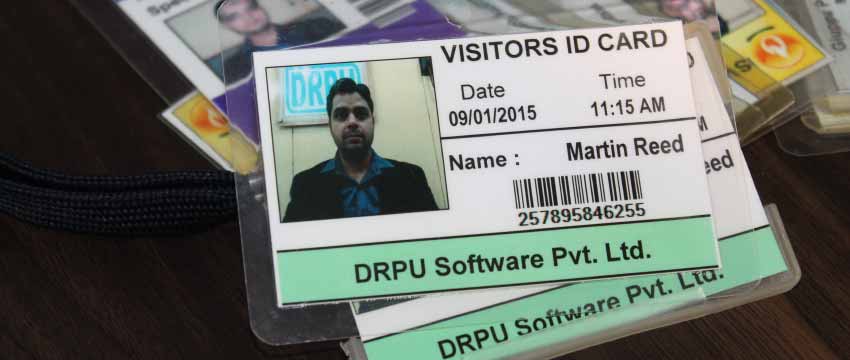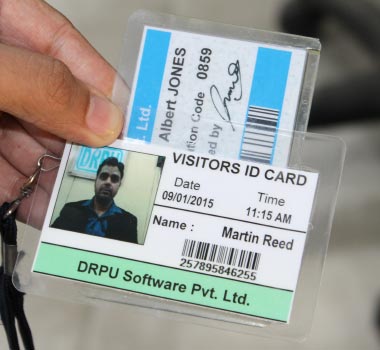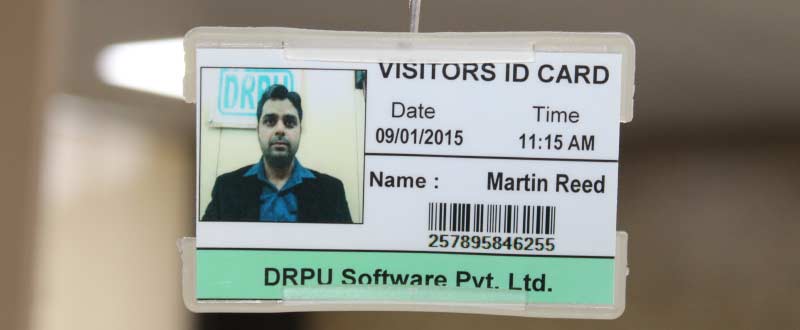Different Types of Visitor ID Cards
There are different types of visitor ID cards that can be used to meet various organizational needs and security requirements. Each type of visitor ID card serves a specific purpose and may have distinct features. Here are some of the common types of visitor ID cards:

-
Temporary Paper or Badge:
This type of visitor ID card is typically made of paper or lightweight material and is meant for short-term use. It is often issued to visitors who need temporary access to a facility or event. These cards are easy to print and distribute quickly. They usually include basic information such as the visitor's name, date of visit, and a designated area for the visitor's photo or a pre-printed visitor badge.
-
Digital ID Card:
With the increasing adoption of mobile apps and digital solutions, some organizations provide visitors with digital visitor ID cards. These cards can be accessed through a mobile app or emailed as a digital pass. Digital ID cards often include a barcode or QR code for scanning and authentication. They offer convenience, ease of use, and eliminate the need for physical cards.
-
Self-Expiring ID Card:
Self-expiring visitor ID cards are designed with a special coating that reveals an expiration indicator after a specific period. These cards are often used for enhanced security and to prevent unauthorized reuse. The expiration indicator can be in the form of a pattern, word, or color change, making it evident when the card is no longer valid. Self-expiring ID cards are useful for short-term visits and do not require the visitor to return or deactivate the card manually.
-
Pre-Printed ID Card:
Pre-printed visitor ID cards are professionally designed and manufactured in bulk before being issued to visitors. These cards typically include the organization's logo, branding, and generic visitor information. The visitor's specific details, such as name and date of visit, can be added manually or through a printing system. Pre-printed cards are convenient for organizations that frequently receive visitors and require a standardized identification system.
-
RFID-Enabled ID Card:
Visitor ID cards can be embedded with RFID (Radio-Frequency Identification) technology, which allows for wireless communication and data transfer between the card and an RFID reader. RFID-enabled cards are often used in organizations where access control systems are in place. The card can be programmed to grant access to specific areas within the facility and track the visitor's movements. This type of card offers convenience and enhances security by automating access control processes.
-
QR Code ID Card:
QR code visitor ID cards contain a QR (Quick Response) code that can be scanned using a smartphone or QR code reader. The QR code may link to additional visitor information, digital documents, or a visitor management system. These cards streamline check-in processes, reduce paperwork, and facilitate digital interactions. QR code ID cards are particularly useful for organizations that prioritize contactless solutions and digital record-keeping.
-
Custom-Printed ID Card:
Custom-printed visitor ID cards are designed and printed specifically for each visitor, typically on-demand or in small quantities. These cards allow for personalized visitor information, including the visitor's name, photo, organization, and any other necessary details. Custom-printed cards are useful when there is a need for individual identification and when visitor information may change frequently.
Security Features of a Visitor ID Card
Visitor ID cards often incorporate various security features to ensure the authenticity of the cardholder and prevent unauthorized access. These security features can vary depending on the level of security required and the technology used. Here are some common security features found in visitor ID cards:
-
Visual Security Features:
Holograms: Holographic overlays or patches with intricate designs can be added to the ID card. These holograms are difficult to replicate and serve as a visual authentication feature.
Microtext: Tiny text or patterns are printed on the ID card, which can be challenging to replicate accurately.
Guilloche Patterns: Intricate and repetitive patterns are printed on the card using precise lines, making forgery more difficult.
UV Printing: Invisible ink or images that are only visible under ultraviolet (UV) light are used to add an extra layer of security.
Optical Variable Ink: Special inks that change color or appearance when viewed from different angles, deterring counterfeit attempts.
-
Personalization Features:
Photograph: A high-resolution photograph of the cardholder is printed on the ID card, making it easily identifiable.
Personalized Information: Details such as the cardholder's name, unique ID number, and organization affiliation are typically included on the card.
Barcodes or QR Codes: Machine-readable codes can be added, containing encrypted information about the cardholder and their access privileges.
-
Technology-Enabled Features:
RFID/NFC Chips: Embedded radio-frequency identification (RFID) or near-field communication (NFC) chips allow for contactless scanning and can store encrypted data, enhancing security and access control.
Magnetic Stripes: These stripes can store data magnetically and are commonly used for encoding information such as access privileges or personal identification numbers (PINs).
Smart Cards: Integrated circuit cards (ICC) or chip cards with microprocessors can store and process data securely. They often require PIN verification or biometric authentication.
-
Tamper-Evident Features:
Holographic Seals: Holographic stickers or seals can be used to cover important areas of the ID card, making it evident if someone tries to tamper with it.
Lamination: The ID card can be laminated to protect it from wear and tear and to prevent alterations.
Durable Materials: ID cards are typically made from robust materials like PVC or polycarbonate to resist tampering, tearing, or counterfeiting attempts.
-
Authentication Features:
Signature Panel: A designated area where the cardholder can sign the ID card, allowing for manual verification of authenticity.
Biometric Data: Advanced ID cards may incorporate biometric features like fingerprints, iris scans, or facial recognition to ensure the cardholder's identity.
-
Security Printing:
Secure Printing Techniques: Various printing methods such as thermal printing, dye sublimation, or laser engraving can be employed to prevent easy replication.
It's important to note that security features can vary based on the specific requirements and regulations of different organizations or institutions. Some ID cards may include additional security elements not mentioned here to provide even greater protection against fraud or unauthorized access.
Visitor ID cards can be Used for Access Control
Visitor ID cards can indeed be used for access control in various settings, such as corporate offices, government institutions, educational campuses, and event venues. These cards play a crucial role in ensuring the security of premises and regulating the movement of visitors within controlled areas. In this comprehensive explanation, we will explore the concept of access control, the benefits of using visitor ID cards, the process of implementing access control systems, and the different technologies and features involved.

Access control refers to the process of granting or denying permissions to individuals attempting to enter or move within specific areas or buildings. It aims to protect assets, maintain privacy, ensure safety, and manage the flow of people efficiently. Access control systems can be categorized into three main types:
Physical Access Control: This type involves the use of physical barriers like doors, gates, turnstiles, or barriers to regulate entry. Examples include key-based locks, electronic card readers, or biometric scanners.
Logical Access Control: This type focuses on controlling access to digital resources such as computer networks, databases, or software applications. It typically involves usernames, passwords, and other authentication mechanisms.
Administrative Access Control: This type encompasses the policies, procedures, and rules established by an organization to govern access privileges. It includes the creation and management of user accounts, assigning access levels, and defining access rights.
Visitor ID cards primarily contribute to physical access control, as they facilitate the identification, verification, and monitoring of visitors in restricted areas. These cards play a vital role in enhancing security measures and streamlining visitor management processes.
Implementing visitor ID cards as part of an access control system offers numerous benefits:
-
Enhanced Security: Visitor ID cards provide a visual and verifiable form of identification, enabling security personnel to distinguish authorized visitors from potential threats or unauthorized individuals.
-
Improved Safety: By tracking and monitoring visitor movements, access control systems with visitor ID cards help ensure the safety of both visitors and staff members. In emergency situations, it becomes easier to account for individuals present within the premises.
-
Efficient Visitor Management: Visitor ID cards streamline the check-in and check-out process for visitors. They allow for quick registration, verification, and record-keeping, reducing waiting times and enhancing overall efficiency.
-
Customized Access Privileges: Visitor ID cards can be programmed with specific access rights and restrictions tailored to the individual visitor's requirements. This ensures that visitors only gain access to authorized areas, maintaining the integrity of sensitive spaces.
-
Regulatory Compliance: Certain industries, such as healthcare or finance, have strict regulations and privacy requirements. Visitor ID cards with access control systems help organizations comply with these regulations by accurately tracking visitor activities and maintaining audit trails.
-
Professional Image: Providing visitors with ID cards enhances the professional image of an organization. It demonstrates a commitment to security and creates a positive impression of the company or institution.
Implementing Access Control Systems with Visitor ID Cards
Implementing access control systems with visitor ID cards involves several key steps:
-
System Design: A thorough assessment of the organization's security needs is conducted to determine the required access control technology, features, and integration with existing systems. Factors such as the size of the facility, number of visitors, and specific access requirements are taken into consideration.
-
Visitor Check-In: When a visitor arrives at the facility, they are required to present their ID card at a designated check-in point. The card is scanned or manually checked for verification. The visitor's entry is logged, and the ID card may be temporarily encoded or activated to grant access to authorized areas.
-
ID Card Printing: Once the visitor's information is collected and verified, the ID card is printed. The card typically includes the visitor's name, photograph, unique identifier, and any relevant access privileges or restrictions. Security features like holograms, barcodes, or RFID/NFC technology can be incorporated.
-
Enrollment Process: Visitors are required to provide their identification documents at the time of enrollment. This information is verified and used to create the visitor ID card. Enrollment methods can include manual data entry, scanning documents, or using self-registration kiosks.
-
Monitoring and Access Control: Throughout the visitor's stay, their movements are tracked using the access control system. Security personnel can monitor visitor activity in real-time, ensuring compliance with access restrictions and responding promptly to any security concerns.
-
Visitor Check-Out: When the visitor is ready to leave, they return the ID card at the designated check-out point. The card is deactivated, and the visitor's departure is recorded. In some cases, the card may be retained for record-keeping or future use.
Technologies and Features in Visitor ID Cards for Access Control
Visitor ID cards for access control can incorporate various technologies and features to enhance security and functionality:

-
RFID/NFC Technology:
ID cards can include embedded RFID or NFC chips that communicate wirelessly with card readers. These chips store encrypted data and enable contactless scanning for access control purposes.
-
Magnetic Stripes:
Magnetic stripes on ID cards can store data magnetically. They are commonly used for encoding information such as access privileges or personal identification numbers (PINs).
-
Barcodes or QR Codes:
Machine-readable codes printed on the ID card can contain encrypted information about the visitor, access rights, or other relevant data. They can be scanned quickly for identification and verification purposes.
-
Biometric Data:
Advanced ID cards may incorporate biometric features like fingerprints, iris scans, or facial recognition to ensure the cardholder's identity. Biometric authentication provides a high level of security and prevents unauthorized use of the ID card.
-
Holographic Security Features:
Holographic overlays or patches with intricate designs can be added to the ID card. These holograms are difficult to replicate and serve as a visual authentication feature, deterring counterfeit attempts.
-
Tamper-Evident Features:
ID cards can include features such as holographic seals or lamination to prevent tampering. Any attempts to alter or tamper with the card become visually evident, alerting security personnel to potential fraud.
-
Integration with Access Control Systems:
Visitor ID cards are often integrated with access control systems, allowing for seamless communication between the ID card, card readers, and centralized security management software. This integration enables real-time monitoring, logging of visitor activities, and remote access control.
-
Cloud-based Visitor Management Systems:
Cloud-based visitor management systems provide a centralized platform for managing visitor data, ID card printing, and access control. These systems offer scalability, remote accessibility, and advanced analytics capabilities.
Visitor ID cards play a crucial role in access control systems by providing secure identification, controlling visitor movements, and enhancing overall security and safety. These cards incorporate various technologies and features such as RFID/NFC, barcodes, biometrics, and tamper-evident measures to ensure authenticity and prevent unauthorized access. By implementing access control systems with visitor ID cards, organizations can achieve enhanced security, efficient visitor management, regulatory compliance, and a professional image. As technology continues to advance, visitor ID cards will evolve to incorporate even more sophisticated security features, further strengthening access control measures and protecting the integrity of restricted areas.